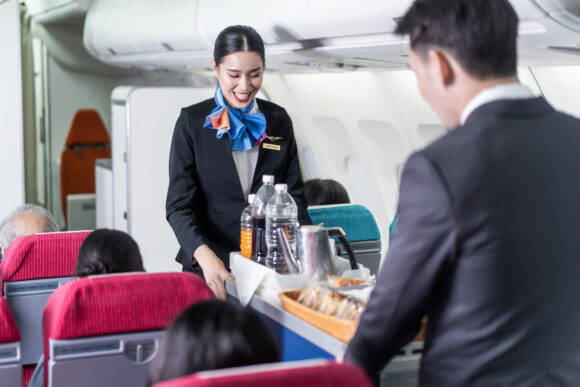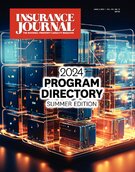For airline passengers and workers alike, it feels like trouble is lurking behind every cloud of late. Frightening scenes of a door plug flying off an airplane mid-flight have dominated news coverage. Clips of collisions and near-misses on the tarmac seem to pop up with alarming regularity. Viral videos of unruly, misbehaving passengers tend to populate our social media feeds.
Each of these isolated incidents captures the public’s attention. But do they accurately reflect a larger reality? And if so, does it mean airline workers face greater risks today than they did a few years ago?
As the managing partner of a leading workers’ compensation defense firm, I have had the unique opportunity to go beyond the viral videos and examine the situation from a firsthand perspective.
Seeing Risk From a Flight Attendant’s Point of View
While defending workers’ compensation cases provides me with a detailed look at the risks that airline employees face, it only offers a partial view. To get the full picture, I needed to see precisely what workers go through every day.
Last year, I had the unique opportunity to experience life as an airline worker from a first-hand perspective. One of Jones Jones LLC’s airline clients allowed me to participate in several days’ worth of flight attendant training. It was an eye-opening experience.
During the training, we worked inside a replicated airplane cabin to recreate many scenarios an airline worker needs to be prepared for on any given flight. It did not take me long to realize that a flight attendant’s job goes far beyond the front-facing work that passengers see, such as taking tickets and distributing drinks and snacks.
Flight attendants must be prepared for anything and everything, including major medical events. In the event of a medical emergency, flight attendants are first responders. They are responsible for every passenger’s safety on every flight, and they receive extensive training in preparation. They also serve as vital links between an airplane in the sky and doctors on the ground.
I left this training with a profound amount of respect for flight attendants and all airline employees. Additionally, I learned that airline employees receive extensive training to prevent injuries and perform their jobs in the safest manner possible. Despite this exhaustive training, flight attendants still face a number of risks and inevitable incidents both in the air and on the ground. However, the firsthand perspective that this training exercise provided allowed me to better understand the reality of the risks, rather than what is reported by the media or in the court room.
More Cases or More Media?
While the recent uptick of airline incidents in the news may portray higher risks for airline workers, today’s media landscape may be more of a contributor to this assumption than actual risk.
Today, millions of people worldwide can take high-quality photos and videos of all manner of human engagement on their smartphones, upload files to social media feeds and send clips to mass media outlets in real time. Such technological advancements also give consumers unprecedented access to breaking news about airline-related incidents. Increased coverage does not, however, equate to an increased risk of worker injuries or a higher number of claims.
In New York, we have not seen a direct upswing in the number of airline-related workers’ compensation claims in recent years despite the added media attention. However, with more attention and immediate access to videos and media stories comes the potential for more claims. This type of scenario could feasibly play out on a per-incident basis, where multiple airline workers may see a viral video of a similar incident to one they have previously encountered and choose to retroactively file a claim.
Top Risks Airline Workers Face
While viral videos sensationalize the types of risks airline employees could face, the reality is far less glamorous. A review of workers’ compensation claims data reveals the five top risks in the airline industry have more to do with repetitive action and small incidents than major aircraft malfunction or unruly passengers. Typical claims often include:
- Muscle strains: Overuse injuries rank as the number one workers’ compensation claim for airline employees in New York. This is due to the day-to-day rigors of the job, including repeated baggage handling and moving about the cabin. Most employees who file claims report symptoms relating to shoulder, neck, elbow and back pain.
- Cabin pressure sickness: If you have ever chewed a stick of gum on an airplane to reduce the “popping” in your ears, you are familiar with the effects of cabin air pressure fluctuations. Severe air pressure changes can cause earaches, ear injuries and sinus pressure, all of which can trigger injuries that lead to a workers’ compensation claim.
- Injuries caused by turbulence: Turbulence is a common occurrence, but sometimes it can be intense. When this happens, it can lead to head injuries and other conditions with potentially grave consequences. This risk escalates when an airline employee does not have time to buckle themselves into a seat safely as the plane hits rough air.
- Cabin door injuries: Airplane doors are extremely heavy. Airline workers must follow a specific and complex protocol to open and close the door, and the process varies depending on the type of plane. Such a repetitive motion can lead to muscle injuries for airline workers, as well as bruising or even contusion if something goes wrong with the process and an airline worker is knocked down or into an object. Proper training can help reduce the risk for these types of injuries.
- Beverage cart injuries: Navigating a beverage cart down a narrow airplane aisle is tricky. Passengers will often stretch their feet into the aisle or have bags or other items hanging out from under the seat. As airline workers make their way down the aisle with the cart, they do not always see such obstacles or have time to stop the cart before hitting them. When the cart bumps into people or objects it raises the risk for injuries and workers’ compensation claims.
While less exciting, these types of incidents are recurring and often lead to injuries for airline workers and workers’ compensation claims for airlines. Such claims can lead to massive financial losses per year in a best-case scenario and can put airline workers out of a job and damage an airline’s reputation in a worst-case scenario.
Mitigating Real Risks
Insurers play a critical role in helping airline carriers and their employees mitigate workers’ compensation risks. Four practical ways insurers and their airline clients can work together to keep airline workers healthier include:
- Ask the right questions. Talk with people who do the job every single day. Ask about the easiest and hardest parts of their job. Take notes during these discussions. Then reflect upon those notes and seek solutions that can address the most frequent concerns.
- Streamline. Observe your employees and seek to reduce the number of repetitive actions or tasks they perform. For example, if you notice employees constantly bend over to retrieve baggage, consider whether raising a baggage claim counter height could ease their burden and help reduce back- and neck-pain-related claims.
- Provide expert-led training. Offering thorough on-the-job education to all airline employees is table stakes. To up-level training, consider selecting the best and brightest employees to lead education sessions. In the training I attended, we received instruction from employees who shared real-life stories that added color and authenticity to our training.
- Infuse empathy and transparency into your workers’ compensation program. Flight attendants and other airline employees care deeply about everyone’s safety. Airlines and their insurance carriers should show the same level of compassion. Ensure workers can talk to a real person — and not a computer — while filing a claim. Respond promptly to all requests. Make any next steps clear to employees and answer their questions so they know precisely what to expect during the process.
News reports about airline mishaps do not tell the real story about airline worker safety risks. While the skies may not be as dangerous as perceived in viral videos, the reality is airline employees still face multiple on-the-job hazards.
By working collaboratively and instilling a sense of humanity into their workers’ compensation programs, insurers and airlines can meet their employees’ needs and mitigate injury risks across the board.
Topics Aviation
Was this article valuable?
Here are more articles you may enjoy.



 Let Good Adjusters, Not Expensive Lawyers, Make the Difference on Claims, CEO Says
Let Good Adjusters, Not Expensive Lawyers, Make the Difference on Claims, CEO Says  BlackSuit Cybercrime Gang Blamed in CDK Hack That Roiled Car Dealers
BlackSuit Cybercrime Gang Blamed in CDK Hack That Roiled Car Dealers  US P/C Insurers Post Best Q1 Underwriting Result In 17 Years
US P/C Insurers Post Best Q1 Underwriting Result In 17 Years  Allstate, Nationwide Post Dramatic Q12024 Homeowners Loss Ratio Drops: S&P
Allstate, Nationwide Post Dramatic Q12024 Homeowners Loss Ratio Drops: S&P 



